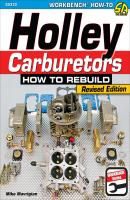Holley Carburetors. Mike Mavrigian
Чтение книги онлайн.

Читать онлайн книгу Holley Carburetors - Mike Mavrigian страница 8
Название: Holley Carburetors
Автор: Mike Mavrigian
Издательство: Ingram
Жанр: Сделай Сам
isbn: 9781613253144
isbn:
Avengers are 4150-series carbs, so the secondary side has metering blocks with serviceable jets.
A quick-change vacuum housing cover allows changing the vacuum spring without the need to disassemble the entire housing unit. The cover is secured with two screws. Simply remove the two screws and then remove the cover and spring. Some carbs, such as the Avenger, have this as standard equipment.
The quick-change feature can be retrofitted to other carbs with a secondary vacuum kit. The housing cover and spring simply pull out. An O-ring seats onto the top of the housing. If it pops loose, be sure to reinstall it into its groove. The vacuum diaphragm spring sticks onto the housing top and is easily changed to a lighter or heavier spring to tune the secondary opening rate.
For off-road truck applications where severe vehicle operating angles are routinely encountered, Holley’s Truck Avenger carb has a main vent tube that connects both primary- and secondary-side main vents. This prevents excess fuel spillover from sloshing out of the vent tubes. This is a 670-cfm Truck Avenger (PN 90670). (Photo Courtesy Holley Performance Products)
The Avenger Truck series is a unique design, intended specifically for truck and off-road applications. It has a single fuel inlet, square fuel bowls with side-hung floats, and an exclusive metering block and vent tube designed to prevent fuel spillover at extreme angles. Flood-free operation accommodates climbing angles up to 40 degrees as well as side-hill maneuvers and nose-down descents up to 30 degrees.
Dominator
The “big boy” of Holley carburetors is the venerable Holley Dominator series, known as the 4500 series; it is often referred to as the “elephant” carb. The Dominator was designed as a large-airflow racing carburetor and debuted in 1969 (although some sources say 1968), initially to address the needs of NASCAR competition. Shortly thereafter, it was offered to the public. Today, the 4500 is extremely popular in drag racing applications. Versions are offered in 1,050, 1,150, and 1,250 cfm, as well as a “street” version rated at 750 cfm that was introduced basically to satisfy hobbyists who hungered for the Dominator look.
The Dominator flange is unique to the 4500 series. You must use a manifold designed for use with a Dominator or install an adapter mounting plate to accept a Dominator. A Dominator cannot bolt to an intake manifold that is not designed for its larger bolt pattern.
The Dominator is often referred to as the “elephant” carb because of its large footprint and its large range of CFM ratings. The Dominator 4500 series ranges from 750 cfm all the way to 1,475 cfm.
Float bowls and metering blocks are similar to those found in the 4150 series, but the 4500 features an appreciably larger main body with the unique secondary linkage located between the front and rear throttle bores, underneath the main body. Throttle bores have a hefty 2.00-inch diameter, compared to 4150/4160 diameters that generally range from 1.563 to 1.688 inches.
The Dominator series was developed specifically for top-end horsepower and torque. The classic Dominator has an aluminum main body with contoured venturi inlets for balanced airflow, a high-flow metering system, and annular boosters. The fuel bowls allow inlet plumbing on either side. The classic Dominator is offered in two- or three-circuit configurations and choices of 1 × 4 or 2 × 4 setups.
The new Gen 3 Dominator line represents an evolution in Dominator design with a 5/16-inch–taller main body that allows larger-radius air entries and fully machined venturi surfaces. It also includes 20 percent larger fuel bowls to eliminate starvation, 12-hole billet booster inserts, adjustable external linkage, and provisions for mounting a throttle position sensor. Annular boosters on the Dominator have a series of fuel orifices spaced around the inside diameter of each booster for superior fuel atomization. Boosters help to pull fuel from the bowls as air passes through them.
The Dominator 4500 has a non-staggered, square bolt-hole pattern. Other 4-barrel models have a staggered pattern with the bolt holes spaced farther apart from front to rear when compared to left-to-right bolt holes.
Throttle bore diameters on 4150- and 4160-series carbs measure 1.563 to 1.688 inches, depending on specific part number.
The throttle bore diameter on Dominator (4500-series) carbs measures 2.00 inches.
You don’t need a tape measure to readily see the difference in throttle bore diameters. The Avenger (left) has 1.688-inch bores, while the 1050 Dominator (right) is gifted with whopping 2.00-inch bores. Bore diameters are even larger on high-volume models, with 1,475-cfm Dominators featuring 2.350-inch bores.
All Holley 4-barrel carburetors (except for the 4500 series) have a baseplate bolt pattern with the baseplate-to-intake manifold bolt holes stagger-spaced 5
Holley Carburetor Models and Types
Holley carburetors are available in different “series” designs. Within each family are variations in CFM, choke design, secondary design (on 4-barrel carbs), etc.
The 4160-, 4150-, and 4500-series carburetors are, by far, the most commonly used. Depending on the engine size and application, carbs in these three series can be applied to street vehicles. However, generally speaking, the 4160 is intended for the street, the 4150 is for serious street and racing, and the 4500 is designed primarily for racing.
For a complete listing of specific Holley carburetor models and the vehicles on which they were installed, please refer to the Appendix.